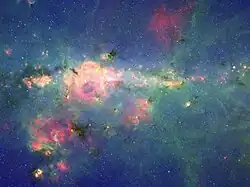 The "Peony Nebula," as discovered by NASA's Spitzer Space Telescope. This three-color infrared composite shows 3.6-micrometre light in blue, 8-micrometre light in green, and 24-micrometre light in red. The Peony nebula is the reddish cloud of dust in and around the white circle, surrounding the Peony nebular star. | |
| Observation data Epoch J2000. Equinox J2000. | |
|---|---|
| Constellation | Sagittarius |
| Right ascension | 17h 46m 18.12s[1] |
| Declination | −29° 01′ 36.5″[1] |
| Characteristics | |
| Evolutionary stage | Slash star |
| Spectral type | Ofpe/WN9[2] |
| Apparent magnitude (J) | 13.0[1] |
| Apparent magnitude (H) | 10.3[1] |
| Apparent magnitude (K) | 8.8[1] |
| J−H color index | 2.7[1] |
| J−K color index | 4.2[1] |
| Variable type | |
| Astrometry | |
| Distance | 26,000[2] ly (8,000[2] pc) |
| Details | |
| Mass | ~100[3] M☉ |
| Radius | 92[2] R☉ |
| Luminosity | 2,950,000[3] L☉ |
| Temperature | 25,100[2][3] K |
| Age | ~2[3] Myr |
| Other designations | |
| Database references | |
| SIMBAD | data |
WR 102ka, also known as the Peony star, is a slash star that is one of several candidates for the most luminous-known star in the Milky Way.[5]
Discovery
WR 102ka lies near the Galactic Center and is essentially totally obscured in visible wavelengths. Thus it must be observed in longer wavelength infrared light, which is able to penetrate the dust. WR 102ka was catalogued in 2002 and 2003 by infrared surveys. It was observed for the Two-Micron All Sky Survey (2MASS) in the near-infrared J, H, and Ks bands, at 1.2 μm, 1.58 μm, and 2.2 μm, respectively,[1] and the ISOGAL survey of candidate young stellar objects at 7 μm and 15 μm.[6]
Narrowband infrared observations of several spectral features around 2 μm showed that WR 102ka was a Wolf Rayet star with a likely classification of WN10.[7] It was also proposed as a possible luminous blue variable.[8]
The Spitzer Space Telescope observed WR 102ka at wavelengths of 3.6 μm, 8 μm, and 24 μm on April 20, 2005. These observations allowed the first reliable calculations of the physical properties of this extremely luminous object.[2]
Other luminous Milky Way stars
The closer star WR 25 may be more luminous than WR 102ka.[9] Another nearer star, Eta Carinae, which was the second-brightest star in the sky for a few years in the 19th century, appears to be slightly more luminous than WR 102ka, but is known to be a binary star system. There is also the more recently discovered Pistol Star that, like the Peony star, derives its name from the shape of the nebula in which it is embedded, and which it has probably created through heavy mass loss via strong stellar winds and perhaps also "mini-supernova-like" eruptions as happened to Eta Carinae around the 1830s–1840s creating the lobes observed by the Hubble Space Telescope.[10]
The luminosities of the Pistol Star, Eta Carinae, and WR 102ka are all rendered somewhat uncertain due to heavy obscuration by galactic dust in the foreground, the effects of which must be corrected for before their apparent brightness can be reduced to estimate their total radiated power or bolometric luminosity.[11] Both Eta Carinae and WR 102ka are believed likely to explode as supernovas or hypernovae within the next few million years.[12][9] As is typical of such extremely massive and luminous stars, both have expelled a considerable portion of their initial mass, when originally formed, in dense, massive stellar winds.[13][9]
See also
References
- 1 2 3 4 5 6 7 8 Skrutskie, Michael F.; Cutri, Roc M.; Stiening, Rae; Weinberg, Martin D.; Schneider, Stephen E.; Carpenter, John M.; et al. (1 February 2006). "The Two Micron All Sky Survey (2MASS)". The Astronomical Journal. 131 (2): 1163–1183. Bibcode:2006AJ....131.1163S. doi:10.1086/498708. ISSN 0004-6256. S2CID 18913331.
- 1 2 3 4 5 6 Barniske, A.; Oskinova, L. M.; Hamann, W. -R. (2008). "Two extremely luminous WN stars in the Galactic center with circumstellar emission from dust and gas". Astronomy and Astrophysics. 486 (3): 971. arXiv:0807.2476. Bibcode:2008A&A...486..971B. doi:10.1051/0004-6361:200809568. S2CID 8074261.
- 1 2 3 4 Oskinova, L. M.; Steinke, M.; Hamann, W. - R.; Sander, A.; Todt, H.; Liermann, A. (2013). "One of the most massive stars in the Galaxy may have formed in isolation". Monthly Notices of the Royal Astronomical Society. 436 (4): 3357. arXiv:1309.7651. Bibcode:2013MNRAS.436.3357O. doi:10.1093/mnras/stt1817. S2CID 118513968.
- ↑ Hamann, Wolf-Rainer; Barniske, Andreas; Liermann, Adriane; Oskinova, Lidia M.; Pasemann, Diana; Ruehling, Ute (2011). "The most luminous stars in the Galaxy and the Magellanic Clouds". Société Royale des Sciences de Liège. 80: 98. arXiv:1012.1875v1. Bibcode:2011BSRSL..80...98H.
- ↑ Steinke, M.; Oskinova, L. M.; Hamann, W. -R.; Sander, A. (2015-01-01). "The Wolf-Rayet stars WR102c and 102ka and their isolation". Wolf-Rayet Stars: 365. Bibcode:2015wrs..conf..365S.
- ↑ Felli, M.; Testi, L.; Schuller, F.; Omont, A. (2002). "Young massive stars in the ISOGAL survey. II. The catalogue of bright YSO candidates". Astronomy and Astrophysics. 392 (3): 971–990. arXiv:astro-ph/9905296. Bibcode:2002A&A...392..971F. doi:10.1051/0004-6361:20020973. S2CID 18314394.
- ↑ Homeier, N. L.; Blum, R. D.; Pasquali, A.; Conti, P. S.; Damineli, A. (2003). "Results from a near infrared search for emission-line stars in the Inner Galaxy: Spectra of new Wolf-Rayet stars". Astronomy & Astrophysics. 408: 153–159. arXiv:astro-ph/0306578. Bibcode:2003A&A...408..153H. doi:10.1051/0004-6361:20030989. S2CID 11814077.
- ↑ Clark, J. S.; Larionov, V. M.; Arkharov, A. (2005). "On the population of galactic Luminous Blue Variables" (PDF). Astronomy & Astrophysics. 435 (1): 239–246. Bibcode:2005A&A...435..239C. doi:10.1051/0004-6361:20042563.
- 1 2 3 "WR 102ka – a Blue Supergiant Star - Assignment Point". Retrieved 2022-03-08.
- ↑ Garner, Rob (2019-07-01). "Hubble Captures the Galaxy's Biggest Ongoing Stellar Fireworks Show". NASA. Retrieved 2022-03-08.
- ↑ Zwicky, F. (1962). "1962IAUS...15..347Z Page 347". Problems of Extra-Galactic Research. 15: 347. Bibcode:1962IAUS...15..347Z. Retrieved 2022-03-08.
- ↑ Elizabeth Howell (2022-01-26). "Eta Carinae's epic supernova explosion comes to life in new visualization". Space.com. Retrieved 2022-03-08.
- ↑ "The turbulent heart of Eta Carinae". www.mpg.de. Retrieved 2022-03-08.